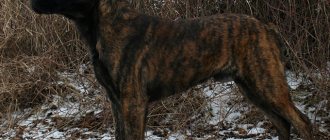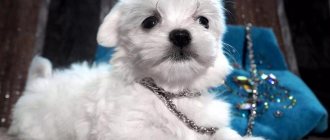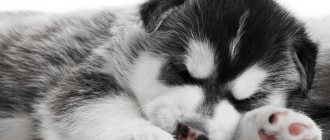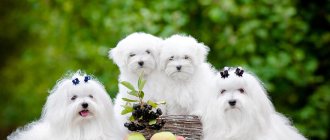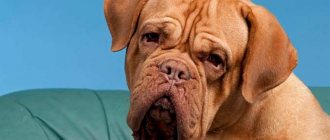| Intelligence: |
| Aggressiveness: |
| For security: |
| For children: |
| Training: |
| Difficulty in care: |
The history of the Czech shepherd dog dates back to ancient times. This is a faithful, kind dog, distinguished by hard work and intelligence. He needs an active, colorful life, filled with events. Despite its large size, it is suitable for both experienced dog breeders and beginners who simply love animals.
History of the breed
As the name suggests, the breed originated in the Czech Republic. It is known that it already existed in the 14th century, but no one knows the exact time of its appearance. The breed is considered a descendant of the German Shepherd. In the Czech Republic, she was so revered that flags were decorated with her image, and she was often described in legends and fairy tales.
In the 20th century, its popularity declined greatly and only in 1985 the breed was restored almost from scratch. The resulting dog became the modern Czech shepherd dog. She was later recognized by local canine organizations.
Appearance
Cattle dog: Scottish, shepherd and other breeds
The Bohemian Shepherd is very similar in appearance to the German and East European Shepherds. The functionality of the dog has been developed over many decades specifically for security and protective activities. She calmly tolerates changes in weather conditions.
Shepherd description:
- light elongated body;
- large wedge-shaped head;
- the transition from forehead to muzzle is smooth;
- large teeth are completely hidden behind the lips;
- round brown eyes are not deep set;
- rectangular body;
- strong back;
- straight lower back (no sagging);
Exterior of the dog
- medium length neck;
- limbs straight, parallel;
- large, tightly folded paws;
- saber-shaped fluffy tail;
- body weight 18-28 kg;
- height at withers 45-55 cm;
- erect small triangular ears;
- dark colored neat nose;
- very thick fur with dense undercoat;
- the hair is long, about 12 cm (shorter on the face, legs, ears);
- The coat color is black with tan everywhere except the back.
Note! A light shade of fur is allowed on the belly, chest and inner thigh. Red-colored tan marks should be clearly defined.
What is the difference between a Hodsky dog and a German Shepherd?
To understand the difference between a Khodsky dog and a German shepherd, you need to put them side by side. In appearance, the “Czech” is almost no different from the German variety. It’s just smaller in size, similar to a smaller copy of a German shepherd, albeit more shaggy.
Important! Bohemian is 12-15 kg lighter and 10-15 cm lower.
The walking dog is more trained for physical activity and speed. She is very obedient and manageable.
German Shepherd
general characteristics
Again, from the name you can guess that the primary purpose of the breed is to herd livestock.
But over time, breeders began to notice its other distinctive qualities. The Czech Shepherd makes an excellent guard for a house, apartment, property, and not just for other animals. They are brave, loyal, hardworking, and therefore can become better than any alarm. In addition, the breed is popular as a companion or pet. Height at the withers varies from 47 to 57 cm , with a total weight of 18-25 kg .
Basic colors
The standard includes the following three types of color:
- Black and black is the most common color. Occurs in more than 90% of individuals. Distinctive color features: a triangular black spot, from the elbows to the tail, and a light color covering the belly, paws and neck. There is a black mask on the face and ears. Its absence is a sign of marriage.
- Zonal (wolf, gray, gray) - this effect is obtained due to the special color of the hairs. At the very root they are light, then a little darker, higher towards the tip they are yellow, and the tip itself is painted black. The most intense and darkest color is on the face, back and tail. The zone color accounts for only 5% of the 100 representatives of the breed.
- Black – the dog’s entire body is covered in a luxurious black fur coat. Insertion of any other color is a defect. According to statistics, black German Shepherds make up only 3% of the total number.
Black puppies become lighter in color as they grow, while pure black puppies remain that way throughout their lives.
Character
The Czech Cattle Dog is intelligent and loyal to its owner. She is hardworking, kind, loves to walk and play. He gets along easily with children, treats them patiently and tolerates all clumsiness without much attention. Other animals in the house do not bother her, but if she is not trained from an early age, she may try to herd them in the house or even children. She will not be aggressive with strangers, but will be reserved. There is practically no aggression in her; she usually warns of trouble or danger with a loud bark, but does not attack strangers without a command.
The only thing this breed cannot stand is loneliness. If you leave an animal unattended for a long time, it can start playing pranks without the owner's permission.
Temperament
The dog described is a loyal friend and brave protector. She is active and curious. She gets along well with small household members and is ready to play for hours with her favorite toy. It is easy to train and instantly remembers numerous commands. With proper upbringing, Bohemian Shepherd puppies quickly get used to discipline and do not show aggression towards other animals.
However, these dogs are extremely distrustful of strangers, but if the owner “gives the go-ahead” to communicate with a stranger, then the dog changes its attitude and shows friendliness. As a rule, a four-legged pet becomes strongly attached to its owner and cannot stand prolonged loneliness. In addition, you should not be aggressive towards these animals. Experienced dog handlers are confident that they will be able to “come to an agreement” with such pets without raising their voices.
Czech herding dogs love playing in the fresh air and enjoy running after a stick and a ball.
Space is important for this breed, so most often owners of private houses own walking dogs. As for a city apartment, your pet needs a warm, cozy place and long walks in the fresh air.
We recommend reading: Brazilian Bulldog (Campeiro) - description of the breed
Maintenance and care
- It’s worth starting in a country house, but not in an apartment. Even large apartments will seem like a cage to him. The house provides great opportunities, development, as well as fresh air.
- Although the animal’s fur is thick, it does not require special care. It practically does not tangle, and therefore you can comb your pet once every 3 days, this will be enough. The breed usually sheds during the summer months. During this period, you can comb it out more often if the animal lives in the house.
- There is no point in bathing your pet often; it doesn’t get very dirty. But if the animal played in the mud or walked in the rain, then it needs to be bathed and dried.
- The dog is large and needs a lot of walks. Even when living in the yard, she needs regular walking for at least 1.5 hours a day. During walks, you don’t just need to walk, walk the dog, he needs jogging, games, obstacles. So during this hour and a half it is worth providing the animal with active rest.
- Do not neglect standard care procedures. Ears need to be cleaned once a week, nails trimmed once a month, it is also recommended to brush the dog’s teeth, but this is at the request of the owners.
- Learning is rarely a problem if done correctly. Moreover, mental stress for the breed is not only necessary, but necessary! Without development, she is bored; with her you need to be a teacher all the time.
- The Czech Shepherd needs to be socialized from an early age. It is advisable to walk her in large parks, where there are many people, children and other animals.
Health
Bohemian Shepherds are strong and resilient animals. The average life expectancy of four-legged friends is from 13 to 15 years. The Khodsky dog is susceptible to diseases of the ears and joints. Representatives of this breed require regular visits to the veterinarian. A specialist will identify a particular disease at an early stage and select the appropriate treatment.
Feeding
There may be problems with your diet. The dog eats both food and regular food; the choice is up to the owner. But the breed sometimes experiences stomach torsion. Therefore, it is important not only to choose the right food, but also to feed the animal on time.
First, you need to decide on the type of food. Natural food is more acceptable, but not everyone has time to cook, and it’s not always easy to be able to add various vitamins in the right quantities. So many people prefer ready-made food. The choice of company should be entrusted to a veterinarian; he still knows better which food is less harmful to the animal’s stomach and is easier to digest. Of course, the dog should always have access to fresh, clean water.
You need to feed your pet after a walk, so that after walking, he can eat and relax, and not run. Puppies are fed three or four times a day, later reducing the amount to 2 times a day.
Bobtail
The shaggy English Bobtail is a friend to sheep and a threat to wolves. Many times he emerged victorious from a fight with a gray predator. In ordinary life, bobtails are not aggressive and have become favorite pets of many families. Their shepherd service is a thing of the distant past, but they have not lost their instinct and are ready to look after all family members around the clock. “Shaggy nannies” have a special affection for children and will never offend them. The breed is rare, the price of a puppy reaches $3000. Nurseries are located in Moscow, St. Petersburg, Smolensk, Yekaterinburg. Bobtail is a screen star, he is often featured in food commercials, and the films “The Taming of the Shrew” and “Cats and Dogs” were filmed with his participation.
In fact, there are many more herding dogs in the world. Almost every corner of the globe where there is a need to herd herds has its own breed. France, Germany, Portugal, Romania, Czechoslovakia, Italy, Belgium, Ireland - they all boast their own “shepherds”. In Australia and Scotland alone there are about five varieties. They all have one quality in common - they are incredibly devoted to people.
- Dogs that look like foxes
- The largest dogs: breeds
- TOP 10 dog breeds for children
Breed photo
How to choose a puppy?
Choosing a puppy on your own, especially if you have no experience, is very difficult. It’s even more difficult not to give in to emotions and not take the first puppy that came running to meet you and started licking your hands.
To avoid mistakes when purchasing a four-legged friend, adhere to the following rules:
Pay attention to the family tree. It is best if the pet’s pedigree is no shorter than 5 generations
Pay attention not only to what your parents look like, but also to your grandparents. Research the nursery's reputation. It is better not to take the breeder’s word for it, but to check whether the kennel’s documents are recognized by international canine organizations. Ask the breeder for documents confirming that the producers do not have a predisposition to serious diseases.
Now let's move on to the most exciting and important moment - meeting the puppies.
Here's what you should pay attention to:
- The bitch and puppies must be kept clean and warm.
- When a stranger appears, the mother behaves with restraint, but wary.
- There should be no more than 8 puppies in a litter. It is acceptable for a large bitch to have ten cubs.
- If the puppies have not yet been sold, they must show you all their littermates. If for some reason the breeder refuses to do this, it means that some of the puppies are clearly defective.
- Branding – puppies older than 2.5 months must have a branding. If it is not there, it means that the puppy received a negative assessment for breeding. inspection.
- It is acceptable for puppies under 4 months of age to have their ears in a semi-erect position. The main thing is that they are placed highly.
- Observe how the puppies move - a confident push with their hind legs should be visible. Mild age-related clumsiness is not critical.
Historical reference
The history of the breed goes back to antiquity and is not rich in facts. It is known that during the times when the Czech Republic was ruled by kings and the Romans conquered the world, people knew about strong, water dogs with a marbled color. Quadrupeds were famous for their efficiency in hunting and were considered a valuable gift.
Centuries passed, and water dogs spread throughout the world. The group included Czech Fouseks, Drathaars, other wire-haired and broad-chested pointers, and a little later Pointers also became famous throughout the world. It is interesting that the first standard of the Czech Wirehaired Pointer dates back to 1882. Official recognition did not save the breed from almost complete extinction in the post-war years.
Breeders played an important role in the destruction of the breed. Puppies were expensive, and to keep the price from falling, only males were sold from the litters. The bitches were left in the kennel or simply killed, but were not sold under any pretext. The concentration of all producers in narrow circles, of course, increased the price, but worsened the quality and reduced the number of dogs.
In the twenties of the 20th century, the Czechs founded the first breed club, the purpose of which was to revive the Czech Wirehaired Pointer. The work began with the selection of dogs that most resembled the Czech Fousek. Naturally, producers with pedigrees were a luxury, but dog handlers had no choice.
The selection was carried out on the basis of exterior and working qualities. The second characteristic was verified by operational tests in real conditions. At this stage, the main inbreeding with other breeds occurred, as a result of which the appearance of the pointer suffered. To restore the characteristic characteristics of the breed, the breeders had to spend more than 5 years. After strengthening five breed lines of the same type, the breed was recognized by the Fédération Cynologique Internationale (FCI).
Choosing a puppy
A Czech Wolfdog puppy can only be confused with a wolf, since the resemblance to it is quite obvious. But a little wolf cub will never become a somewhat domesticated pet. Therefore, you need to buy a Volchek only in specialized nurseries that have breeding animals, as well as a good reputation and positive reviews. A competent and reliable breeder always gives the buyer not only a puppy card, but also a veterinary book with vaccination records, as well as copies of the parents’ pedigrees.
Only a specialist can tell a small wolf puppy from a wolf
Puppy cost
Since the Czechoslovakian Wolfdog breed is very rare in our country, they are quite expensive. On average, prices start at $800, but can go up to $1,000 or more.
There are several nurseries in Russia where you can buy Czech Wolfdog puppies
